| 2 April |
• yesterday • tomorrow |
| Optional Memorial of Saint Francis of Paola |
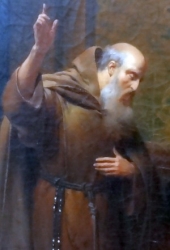
• Franciscus de Paula
• Francis the Fire Handler
• Francesco di Paola
Francis's parents were childless for many years, but following prayers for the intercession of Saint Francis of Assisi, they had three children; Francis was the oldest. Following a pilgrimage in his teens to Rome and Assisi in Italy, he became a hermit in a cave near Paola. Before he was 20 years old he began to attract followers. By the 1450's the followers had become so numerous that he established a Rule for them and sought Church approval. This was the founding of the Hermits of Saint Francis of Assisi, who were approved by the Holy See in 1474. In 1492 they were renamed the Franciscan Order of Minim Fiars, which means they count themselves the least of the family of God.
Prophet. Miracle worker. Reputed to read minds. In 1464 Francis wanted to cross the Straits of Messina to reach Sicily, but a boatman refused to take him. Francis laid his cloak on the water, tied one end to his staff to make a sail, and sailed across with his companions. Franz Liszt wrote a piece of music inspired by the incident.
Defender of the poor and oppressed. Gave unwanted counsel and admonitions to King Ferdinand of Naples and his sons. Traveled to Paris at the request of Pope Sixtus IV to help Louis XI prepare for death. Used this position to influence the course of national politics, helping restore peace between France and Brittany by advising a marriage between the ruling families, and between France and Spain by persuading Louis XI to return some disputed land.
In an old tradition that has certain saints opposing on an equivalent demon, Francis is the adversary of Belial since his simple humility cancels the demons raging pride.
27 March 1416 at Paola, Calabria, Kingdom of Italy (part of modern Italy)
• 2 April 1507 (Good Friday) at Plessis, France of natural causes
• in 1562 Huguenots broke open his tomb, found his body incorrupt, and burned it; the bones were salvaged by Catholics, and distributed as relics to various churches
1519 by Pope Leo X
• against fire
• against plague
• against sterility
• boatmen, mariners, sailors, watermen
• naval officers
• travellers
• 7 cities
• man with the word "charitas" levitated above a crowd
• man holding a skull and scourge
• man sailing on his cloak
• green rose
Fix your minds on the passion of our Lord Jesus Christ. Inflamed with love for us, he came down from heaven to redeem us. For our sake he endured every torment of body and soul and shrank from no bodily pain. He himself gave us an example of perfect patience and love. We, then, are to be patient in adversity.
Take pains to refrain from sharp words. Pardon one another so that later on you will not remember the injury. The recollection of an injury is itself wrong. It adds to our anger, nurtures our sins and hates what is good. It is a rusty arrow and poison for the soul. It puts all virtue to flight.
Be peace-loving. Peace is a precious treasure to be sought with great zeal. You are well aware that our sins arouse God's anger. You must change your life, therefore, so that God in his mercy will pardon you. What we conceal from men is known to God. Be converted, then, with a sincere heart. Live your life that you may receive the blessing of the Lord. Then the peace of God our Father will be with you always. - from a letter by Saint Francis of Paola
https://catholicsaints.info/saint-francis-of-paola/
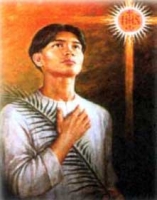
Peter Calungsod
Educated by the Jesuits in the Visayas, a section of the Philippines. Pedro could read, write and speak Visayan, Spanish, and Chamorro, paint, draw, sing, and worked as a carpenter. Teenage catechist who worked with Spanish Jesuit missionaries to the violent Chamarros in the Ladrones Islands (modern Marianas) in 1668. Because he was a Christian on a mission to catechize the Chamorros, and Baptisms, Calungsod was murdered by two natives. He died trying to defend Father Diego Luis de San Vitores. Martyr.
• c.1654 in Ginatilan, Cebu, Philippines
• named for Saint Peter the Apostle
• hacked to death with a catana on 2 April 1672 at Tomhom, Guam
• mutilated body thrown into the sea
• 5 March 2000 by Pope John Paul II at Vatican City
• the investigation proved the miraculous cure of bone cancer through Pedro's intercession
21 October 2012 by Pope Benedict XVI
young people
Almighty God, by whose gift Blessed Pedro the Martyr witnessed to the Gospel, even to the shedding of his blood: grant, by his example and intercession, that we too may live for You, boldly and steadfastly, confessing Your name through our Lord, Jesus Christ, Your Son, who lives and reigns with You in the Holy Spirit, one God, forever and ever. Amen. - Official Prayer for Pedro Calungsod
Blessed Pedro Calungsod, Young migrant, Student, Catechist, Missionary, Faithful friend, Martyr, you inspire us by your fidelity in times of adversity, by your courage in teaching the faith in the midst of hostility, and by your love in shedding your blood for the sake of the Gospel. Make our troubles your own (here mention your request), and intercede for us before the throne of Mercy and Grace so that as we experience the help of heaven we may be encouraged to proclaim and live the Gospel here on earth. Amen. - Novena for Blessed Pedro Calungsod
Pedro Calungsod was born around the year sixteen fifty-four, in the Visayas region of the Philippines. His love for Christ inspired him to train as a catechist with the Jesuit missionaries there. In sixteen sixty-eight, along with other young catechists, he accompanied Father Diego Luís de San Vitores to the Marianas Islands in order to evangelize the Chamorro people. Life there was hard and the missionaries also faced persecution arising from envy and slander. Pedro, however, displayed deep faith and charity and continued to catechize his many converts, giving witness to Christ by a life of purity and dedication to the Gospel. Uppermost was his desire to win souls for Christ, and this made him resolute in accepting martyrdom. He died on the second of April, sixteen seventy-two. Witnesses record that Pedro could have fled for safety but chose to stay at Father Diego's side. The priest was able to give Pedro absolution before he himself was killed. May the example and courageous witness of Pedro Calungsod inspire the dear people of the Philippines to announce the Kingdom bravely and to win souls for God! - Pope Benedict XVI's canonization homily for Saint Pedro
https://catholicsaints.info/saint-pedro-calungsod/
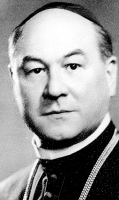
Vilhelm, Gulielmus, William
Born to the Hungarian nobility. Ordained on 24 August 1915. Chosen bishop of Gyõr, Hungary on 21 January 1941 by Pope Pius XII. Conventual chaplain ad honorem of the Sovereign Military Order of Malta. Known for his hard work, his efforts for social justice, his support of the poor, his protection of the weak. Provided emergency supplies to Jews being deported through his town. Sheltered those made homeless by air raids. Hid and protected women from brutalities of Russian soldiers who were closing in on Germany at the end of World War II. Shot on a Good Friday by a drunken Red Army officer who was chasing women who had fled to bishop Vilmos for protection; he died three days later.
29 February 1892 at Segesvár, Transylvania, Hungary
shot on 2 April 1945 at Gyõr, Hungary
9 November 1997 by Pope John Paul II at Saint Peter's basilica, Vatican City
The Cross strengthens the weak, it curbs the powerful. - episcopal motto of Blessed Vilmos
The intimate sharing in the mystery of Christ, the new and perfect Temple in whom full communion between God and man is realized (cf. John 2:21), shines forth in the pastoral service of Blessed Vilmos Apor, whose life was crowned with martyrdom. He was the "parish priest of the poor", a ministry which he continued as a Bishop during the dark years of the Second World War, working as a generous benefactor of the needy and the defender of the persecuted. He was not afraid to raise his voice to censure, on the basis of Gospel principles, the injustices and abuses of power towards minorities, especially towards the Jewish community. In the image of the Good Shepherd who lays down his life for his sheep (cf. John 10:11), the new blessed lived his fidelity to the paschal mystery, ultimately making the supreme sacrifice of his own life. His murder occurred precisely on Good Friday: he was shot to death while defending his flock. Through his martyrdom he thus experienced his own Passover, passing from the heroic witness of love for Christ and of solidarity with his brothers and sisters to the crown of glory promised to faithful servants. The heroic witness of Bishop Vilmos Apor honours the history of the noble Hungarian nation and is held up today for the admiration of the whole Church. May it encourage believers to follow Christ in their lives without hesitation. This is the holiness to which all the baptized are called! - from the beatification homily by Pope John Paul II, 9 November 1997
https://catholicsaints.info/blessed-vilmos-apor/
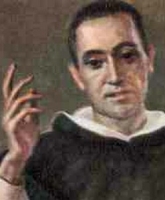
• Francis Coll Guitart
• Frans Coll Guitart
One of ten children. His father, Peter, died when Francis was only four. Confirmed in 1818 at age six. Entered the seminary at Vichy, France in 1822 at age ten. Student with Saint Anthony Mary Claret. Even as a kid he taught grammar and catechism to local children. Francisco joined the Dominicans at Vichy in 1830 at age eighteen. When monastic orders were suppressed by the government, Francis continued to study covertly. Ordained on 28 March 1836 at Vichy.
Parish priest of Arles, France. Re-assigned to Moya in 1839, an area devastated by war, awash with starving refugees. He established charitable organizations to feed and house them, and he worked with the poor and displaced for ten years. Helped Saint Anthony Claret found the Apostolic Fraternity in 1846. Director of the tertiaries in Vichy. In 1850 he re-opened the suppressed Dominican monastery, and began a program of preaching throughout the Catalan region. Worked with cholera victims during the epidemic that struck in 1854.
Founded the Congregation of the Dominican Sisters of the Annunciation of the Blessed Virgin Mary (La Annunciata) in 1856, a teaching branch of tertiaries; by his death the order had grown to fifty houses, and today there are over 140 in Europe and America. Struck blind during a homily given at Sallent on 2 December 1869; his health was never the same, but he refused to retire. When the Dominicans were allowed to officially return to the region in 1872, they found that Francis has somehow maintained the primary structures, physical and administrative, and instead of starting all over, they reclaimed what was theirs, and took up their work where they had left off.
18 May 1812 in Grombeny, Catalan Pyrenees, Spain
• 2 April 1875 in Vic, Barcelona, Spain of natural causes
• relics enshrined in the La Annunciata motherhouse
11 October 2009 by Pope Benedict XVI
God of all truth, you chose Blessed Francis to make known the name of your Son and to instruct Christian people in holiness. By the help of his prayers may the true faith be continually sustained and grow through the ministry of preaching. We ask this through our Lord Jesus Christ, your Son, who lives and reigns with you and the Holy Spirit, one God, for ever and ever. - General Calendar of the Order of Preachers
https://catholicsaints.info/saint-francisco-coll-guitart/

• Laura Evangelista Alvarado Cardozo
• María of Saint Joseph
• Maria de San José Alvarado
Laura made her First Communion, and a private vow of chastity, on the feast of the Immaculate Conception in 1888. In her late teens she set up a catechism school for poor children in her home. A smallpox epidemic broke out in her home town, and Laura worked with the sick in the hospital started by her parish priest and spiritual director, Father Vicente Lopez Aveledo. This work, and the lack of resources that they had to work with, led her and Father Vincente to found the Augustinian Recollect Sisters of the Heart of Jesus in 1901; the Sisters are a nursing order with a mission to care for the sick, the elderly and orphans. She made her profession, took the name María of Saint Joseph, and was recognized as founder of the Order on 13 September 1903. Mother María then spent the rest of her life, over 60 years, growing the Order and caring for the poor and neglected; she founded 37 houses around Venezuela. To support her endless work, she cultivated a contemplative life by making Eucharist hosts, and spending nights in Eucharistic adoration.
25 April 1875 in Choroni, Venezuela as Laura Evangelista
• 2 April 1967 in Maracay, Aragua, Venezuela of a blood clot
• buried in the chapel of the Immaculate Conception Home in Maracay, the location she had requested, and which has become a pilgrimage site
• body found incorrupt on 19 January 1994
• re-interred in a new sarcophagus in the same chapel in September 1994
• 17 May 1995 by Pope John Paul II at Saint Peter's Basilica in Rome, Italy
• Blessed María was the first native of Venezuela to be beatified
• the beatification miracle involved the cure of Sister Teresa Silva
• Augustinian Recollect Sisters of the Heart of Jesus
• nurses
Those rejected by everyone are ours; those no one wants to take are ours. – Blessed Maria
https://catholicsaints.info/blessed-mary-of-saint-joseph-alvarado-cardozo/

• Mykola Carneckyj
• Mykola Charnetsky
• Nicholas Charnetsky
• Nikolas Carneckyj
• 6 January as one of the Martyrs of Ukraine
• 27 June as one of the Martyrs Killed Under Communist Regimes in Eastern Europe
Greek Catholic. Ordained on 2 October 1909. Received a doctorate in Dogmatic Theology in Rome, Italy. Entered the Redemptorist novitate at Zboysko in 1919, making his vows on 16 September 1920. Spiritual director and professor at the seminary in Stanislaviv (modern Ivano-Frankivsk), Ukraine. Appointed Apostolic Visitor to Ukrainian Catholics in Volyn and Polyssya by Pope Pius XI in 1926. Bishop on 2 February 1931.
Apostolic Exarch in Volyn and Pidlyashia during the Bolshevik occupation. Arrested for his faith on 11 April 1945 by the NKVD; sentenced to six years forced labour in Siberia. Worked in a blacksmith shop, ministered to other prisoners, and ruined his health. His six year sentence continued for eleven years, and after his release he lived under constant surveillance and irregular torture. Martyr.
14 September 1884 at Samakivtsi, Horodensk District, Halychyna, Ukraine
• 2 April 1959 at Lviv, Ukraine
• buried there
• city authorities have to cover the grave with fresh earth each week as pilgrims carry off so much
27 June 2001 by Pope John Paul II in Ukraine
https://catholicsaints.info/blessed-mykolai-charnetskyi/

Affianus, Amphian, Amphianus, Anphian, Aphian, Aphianus, Apian, Apphian, Apphianos
Born to wealthy, prominent and non-Christian family. Brother of Saint Aedesius of Alexandria. Well educated, studying rhetoric, philosophy and civil law in Beirut, Lebanon. Convert to Christianity. Friend of Eusebius of Caesarea; the pair made a pilgrimage to Palestine. Studied under Saint Pamphilus.
In May 305, Emperor Maximinus declared that everyone should take part in public sacrifices in celebration of his coronation. When it came time for the sacrifices in his city, Appian went to the temple and stopped the official, Urbanus, from offering incense to an idol, explaining that it was impious to worship an idol instead of the true God, and berating the judge for doing it. Appian was beaten, imprisoned, his flesh torn off with iron claws, and roasted over a slow fire. He was then ordered to sacrifice to the Roman gods; he declined. Martyr.
c.287 in Gagae, Asia Minor
• drowned in April 306 in Caesarea, Palestine by having stones tied him and then being thrown into the sea
• an earthquake immediately struck the area and Appian's body, stones and all, immediately washed back up onto the beach
I confess Christ, the one God, and the same God with the Father. - Saint Appian to the court when ordered to sacrifice to idols
https://catholicsaints.info/saint-appian-of-caesarea/

• John Pain
• John Paine
• 25 October as one of the Forty Martyrs of England and Wales
• 29 October as one of the Martyrs of Douai
Convert. Studied at Douai, France in 1574. Ordained on 7 April 1576. Returned to Ingatestone, Essex, England, ministering to covert Catholics and bringing many back to the Church. Worked with Saint Cuthbert Mayne. Arrested for his work in 1577, he was exiled to Douai in 1579. Returned to England in 1581 to resume his work. Betrayed by by John Eliot, a known murderer who made a career of denouncing Catholics and priests for bounty, he was arrested in Warwickshire, tortured several times, accused of plotting to kill the queen based solely on Eliot's testimony, and executed. Martyr.
diocese of Petersborough, Northampton, England
hanged, drawn, and quartered on 2 April 1582 at Chelmsford, Essex, England
25 October 1970 by Pope Paul VI
https://catholicsaints.info/saint-john-payne/
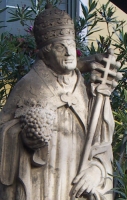
23 January in Langres, France
Bishop of Langres, France in 374. During a priod of persecution of the Church, Urban hid for a while in a vineyard. There he converted the vine dressers, who then helped him in his covert ministry. Due to their work, and to Urban's devotion to the Holy Blood, he developed great affection to all the people in the wine industry, and they for him.
c.390 of natural causes
• against alcoholism
• against blight
• against fainting
• against faintness
• against frost
• against storms
• barrel makers, coopers
• Dijon, France
• gardeners
• Langres, France
• vine dressers
• vine growers
• vintners
• bishop with a bunch of grapes or a vine at his side
• bishop with a book with a wine vessel on it
• bishop holding a triple cross with grapes on a missal nearby
https://catholicsaints.info/saint-urban-of-langres/

Giovanni Croci
Born to a peasant family, he was a shepherd as a boy. He early showed signs of a religious vocation, and joined the Franciscans at age 19. Ordained in 1757. Taught philosophy and theology. Mission preacher. Minister-Provincial of Umbrian in 1781; his term was noted for insisting on study and adherence to his Order's Rule by the friars, and support of the friars by their superiors. Established a cloister at Monte Luco near Spoleto, Italy, and lived there in solitude and silence for several years; it was closed in 1809 due to political suppression of monastic houses, and Leopold returned to life as a parish priest, working in periods of silent prayer whenever his schedule permitted. The community at Monte Luco was restored in 1814, Leopold immediately returned there, and spent his remaining months as a prayerful, silent monk.
30 October 1732 in Gaiche di Piegaro, Perugia, Italy
2 April 1815 in Monteluco, Perugia, Italy of natural causes
12 March 1893 by Pope Leo XIII
https://catholicsaints.info/blessed-leopold-of-gaiche/
• Arnulf I
• Arnulf of Louvain
• Arnulf of Lovanium
• Arnolf of Löwen
• Arnulf of Villers
• Arnulfus Lovaniensis
• Arnolfo, Arnoul
Cistercian monk. Abbot at Villers-la-Ville, Brabant (in modern Belgium) for 10 years. He expanded the abbey, made it a center of piety and mysticism, and compiled the first records of the abbey, covering the years 1146 to 1240. Noted poet. He opposed the scholasticism and formal education system being implemented at the time, and refused to help with the construction of the Saint-Bernard college in Paris, France as he thought the scholastic movement was destroying mystical life. Late in life, he retired from the abbacy to devote his remaining days to prayer and study.
early 13th century in Leuven, Belgium
1276 the abbey at Villers-la-Ville, Brabant (in modern Belgium) of natural causes
https://catholicsaints.info/blessed-arnulf-of-leuven/
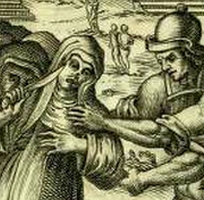
• Ebbe of Coldingham
• Abb, Aebbe, Ebba
Abbess at Coldingham, Berwickshire, Scotland, a double monastery that had been founded by Saint Ebbe the Elder, and which was the largest in the country at the time. When the monastery was attacked by Scandinavian pirates, Ebbe gathered her nuns and exhorted them to save themselves from falling into the hands of the pirates by voluntary disfiguring themselves. She then set an example by cutting off her own nose and upper lip; the other nuns did the same. When the Vikings broke into the convent, they were so horrified and angry by what the women had done to escape being raped, they locked them all in, set fire to the house, and burned them all to death.
burned to death on 2 April 870 at Coldingham monastery, Berwickshire, Scotland
https://catholicsaints.info/saint-ebbe-the-younger/
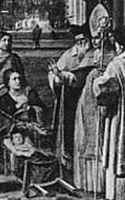
Abbondio, Abondius, Abundias
Priest. Bishop of Como, Italy. Noted theologian. Attended the Council of Constantinople in 450. Diplomat from Pope Leo the Great to Emperor Theodosius II. Papal legate to the Council of Chalcedon in 451. Attended the Council of Milan in 452. Fought Eutychianism, which denied Jesus' human nature, and Nestorianism. Sometimes credited with the authorship of the Te Deum.
at Thessalonica, Greece
469 of natural causes
Como, Italy
raising a rich pagan's son to life
https://catholicsaints.info/saint-abundius-of-como/

Eustasius, Eustatius, Eustathius, Eustache, Eustochius, Eustachius
Monk. Spiritual student of Saint Columbanus. Head of the monastic school at Luxeuil Abbey. Abbot of Luxeuil in 611. During his abbacy the abbey had 600 monks and ran a seminary that sent many bishops and saints into the world. Noted for his humility, lengthy fasts, and for spending his time either at work or prayer. Healed Saint Sadalberga of blindness.
c.560
c.629
https://catholicsaints.info/saint-eustace-of-luxeuil/

Jesuit missionary priest. Founded the first Catholic church on the island of Guam. Established the Spanish presence in the Mariana Islands.
13 November 1627 in Burgos, Spain
2 April 1672 in Tumon, Guam
6 October 1985 by Pope John Paul II
https://catholicsaints.info/blessed-diego-luis-de-san-vitores-alonso/

• Theodora of Tyre
• Theodora of Tyros
• Theodora of Caesarea
• Teodora, Theodosia
Imprisoned, tortured and executed in her late teens for encouraging other martyrs to not give up their faith. Martyr.
c.290 in Tyre
thrown into the sea to drown at Caesarea, Palestine c.317
https://catholicsaints.info/saint-theodora-of-tiria/
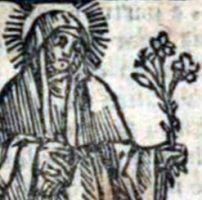
Alexandrine, Sandrina
Poor Clare nun. Founded the Poor Clare monastery in Foligno, Italy where she was admired for her great piety.
1385 in Sulmona, Italy
2 April 1458 of natural causes
https://catholicsaints.info/blessed-alessandrina-of-foligno/
Drogon, Dreux, Druon
After leading a worldly and dissolute life, Drogo became a Benedictine monk at the abbeys of Fleury-sur-Loire and Baume-les-Messieurs in France. Noted for his piety. Around 950, he received a vision of Saint Benedict of Nursia, confirming his conversion to religious life.
https://catholicsaints.info/blessed-drogo-of-baume/
Domenico, Dominic
24 November as one of the Martyrs of Vietnam
Dominican priest. Martyr.
c.1775 in Trung Lao, Nam Ðinh, Vietnam
2 April 1839 in Nam Ðinh, Vietnam
19 June 1988 by Pope John Paul II
https://catholicsaints.info/saint-daminh-tuoc/

• Virgin of Glen-Seichis
• Bromana, Bronacha, Bronanna, Bronagh, Bronaha
Nun. Abbess of Gleannsechis (Kill-sechis), Ireland.
https://catholicsaints.info/saint-bronach-of-glen-seichis/

Nicet, Nicetus, Nizier, Nicezio
Nephew of Saint Sacerdos of Lyons. Bishop of Lyon, France in 553. Worked to revive ecclesiastical chant.
573 of natural causes
https://catholicsaints.info/saint-nicetius-of-lyon/
Megingaud, Meingos
Benedictine monk. Abbot of at Weingarten abbey in Swabia (in modern Germany) c.1188.
c.1200
abbot supervising construction
https://catholicsaints.info/blessed-meingosus-of-weingarten/
Longis, Lenogisil
Priest. Founded a monastery in Maine, France. Spiritual teacher of Saint Agnofleda of Maine.
653 of natural causes
https://catholicsaints.info/saint-lonochilus-of-maine/
Agneflette, Noflette
Nun. Spiritual student of Saint Lonochilus of Maine.
Switzerland
638 of natural causes
https://catholicsaints.info/saint-agnofleda-of-maine/
King of Scotland. Died in battle fighting invading heathens, and thus considered a martyr.
• 874
• buried on Iona
https://catholicsaints.info/saint-constantine-of-scotland/
Rufin
Hermit at Glendalough, Ireland.
https://catholicsaints.info/saint-rufus-of-glendalough/
Young girl in 6th century Rome, Italy who had visions and mystical experiences. Saint Gregory the Great wrote about her.
https://catholicsaints.info/saint-musa/
Bishop of Capua, Italy in 541. Noted ecclesiastical writer.
554
https://catholicsaints.info/saint-victor-of-capua/
Gortonian, Gordian, Gurgoniana
Martyr.
https://catholicsaints.info/saint-gordonian/
Martyr.
https://catholicsaints.info/saint-magnus-2-april/
Martyr.
https://catholicsaints.info/saint-donatus/
Martyr.
https://catholicsaints.info/saint-julius/
A group of ten Christians martyred together in Africa, date unknown. We have six of their names - Marcellinus, Procula, Quiriacus, Regina, Satullus and Saturnin, but no other information has survived.
https://catholicsaints.info/martyrs-of-africa-2-april/
Sixteen Christians who were martyred together in Thessalonica in Greece, date unknown. We know nothing else about them but 13 of their names – Agapitus, Agatophus, Cyriacus, Dionysius, Gagus, Julianus, Mastisius, Proculus, Publius, Theodoulus, Urbanus, Valerius and Zonisus.
https://catholicsaints.info/martyrs-of-thessalonica-2-april/
• Augustine of Ancona
• Conall of Clonallan
• Elizabeth Vendramini
• Floberde
• Genoveva of Brabant
• Gregory of Nicomedia
• Heinrich von Baumburg
• Polycarp of Alexandria
• Thetwif of Minden
• Titus the Miracle Worker
CatholicSaints.Info Portable Edition